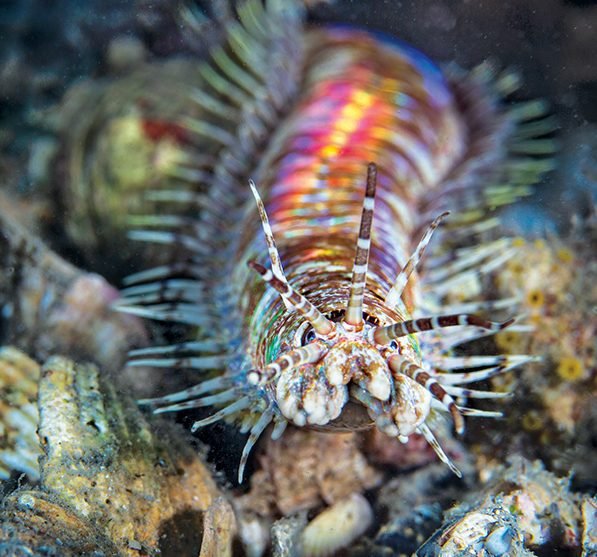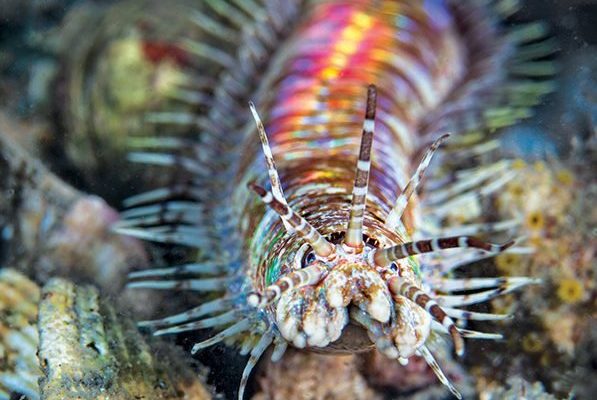
Now, you might be wondering why red light is your best buddy in this adventure. It turns out that many marine animals, including our friend the bobbit worm, are less sensitive to red light. This means you can sneak a peek at them without startling them away. That’s where tools like specialized red LED lights come into play. Let’s dive into how you can set everything up for a successful night expedition with bobbit worms.
Understanding Bobbit Worms
Bobbit worms are long, segmented creatures that can reach impressive lengths—some even up to 10 feet! They spend most of their lives buried in the sand or mud, leaving just their colorful tentacles exposed. These tentacles not only serve as a warning to other creatures but also help catch unsuspecting prey. When something swims too close, the bobbit worm strikes with unbelievable speed, pulling the catch into their burrow.
You might be curious about their habitat. Bobbit worms are typically found in warm, tropical waters, often in coral reefs. They prefer sandy or muddy substrates, where they can easily camouflage themselves. So, if you’re near a reef at night, you might just stumble upon one of these intriguing predators.
While most people might see them as simply creepy crawlies, there’s so much more to discover. Observing them at night, with the help of red light, opens up a world of behavior that many miss in the daytime. Regular lights can scare them away, making a red light your best approach for a closer look.
Choosing the Right Red Light
Not all lights are created equal when it comes to observing bobbit worms. You need a red light that’s bright enough to allow you to see, yet gentle enough not to alarm these sensitive creatures. Look for lights specifically designed for night viewing or underwater exploration. For instance, LED lights that emit a red wavelength are ideal.
When selecting a light, consider the following features:
- Brightness level: A dimmable option is great for adjusting to the conditions around you.
- Beam angle: A wider beam lets you cover more area, while a focused beam helps you spot individuals.
- Durability: If you plan on getting wet or sandy, ensure your light is waterproof and robust.
Brands like **Mactronic** and **Nitecore** offer excellent options specifically for marine settings. These lights are built to withstand saltwater conditions and have a good battery life, which is essential for long nights searching for bobbit worms.
Preparing for the Adventure
Once you’ve got your red light in hand, it’s time to prepare for the observation. First, check the weather and tide charts. Going at low tide might expose areas where bobbit worms are most active. Plan to arrive at your location about an hour before sunset. This way, you can set up and let your eyes adjust to the darkness.
Bring along a few other essentials for your exploration:
- Water shoes: Protect your feet while you navigate rocky or sharp surfaces.
- Snorkel gear: If you want a close-up look, a mask and snorkel will help.
- A buddy: Don’t go alone! Having someone with you makes it safer and more fun.
Before you jump into the water, take a few moments to familiarize yourself with the area. Look for the right spots where bobbit worms might be hiding. They often prefer places with plenty of crevices or where the sand meets rocks.
How to Use Red Light Effectively
Once the sun sets and it’s time to utilize your red light, here’s how to do it effectively. Start by turning on your light and adjusting the brightness to the lowest setting. This will help not just to avoid scaring the worms but also to preserve your night vision.
As you move, make slow, deliberate movements. Bobbit worms are surprisingly sensitive to vibrations in the water and can sense movement quite well. If you rush, you’re likely to frighten them into their burrows.
Use your red light to scan the ocean floor carefully. Look for any movement or color changes in the sand. Remember, bobbit worms often keep most of their bodies hidden, with only their tentacles peeking out. They could be right in front of you without being obvious!
Common Challenges and Solutions
One of the biggest challenges when observing bobbit worms is actually spotting them. Since they can blend so well into their surroundings, you might need patience. Here are a few tips to increase your chances:
- Be quiet: The quieter you are, the more likely you’ll observe their natural behavior.
- Use a buddy system: Having someone else to help look makes it easier to spot them.
- Move slowly: Jerky movements can scare them away—slow and steady wins this race!
Another common issue is light malfunction. If your red light starts flickering or goes out, don’t panic. Always carry extra batteries or a backup light. Checking your equipment beforehand could save you a lot of hassle during your search.
If you still can’t find any bobbit worms, consider altering your location slightly. Sometimes, repositioning just a few feet can make all the difference in spotting one.
Respecting the Environment
As you enjoy the thrill of observing bobbit worms, it’s vital to respect their habitat. Here’s the thing: these creatures are essential to their ecosystem, acting as both predator and prey. Here are some simple ways to ensure your exploration doesn’t disrupt their environment:
- Leave no trace: Take all your trash with you and avoid disturbing the sand unnecessarily.
- Avoid touching: Keep your hands to yourself. Interfering with their habitat can stress them out.
- Educate others: Share your experience and encourage friends to observe responsibly.
By maintaining a respectful distance and being mindful of their environment, you can help keep these incredible creatures thriving for future generations to enjoy.
Wrapping It Up
Exploring the underwater world of bobbit worms at night can be a magical experience when done right. Using red light not only enhances your visibility but also allows you to observe these fascinating creatures in their natural behavior without disturbing them.
With the right equipment, careful preparation, and respect for the environment, you’ll become a nighttime explorer, shedding light on one of nature’s wonders. So gather your gear, head out to the ocean, and enjoy the unique thrill of watching bobbit worms under the stars!

